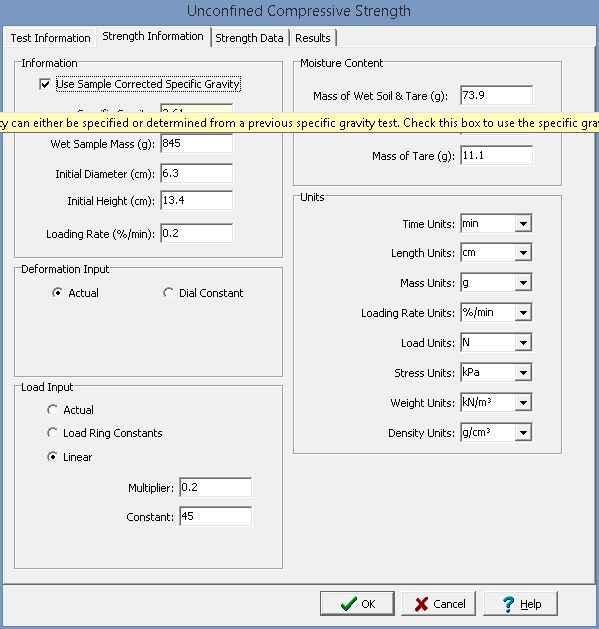|
<< Click to Display Table of Contents >> Strength Information Tab |
  
|
|
<< Click to Display Table of Contents >> Strength Information Tab |
  
|
This tab is used to specify the information for the specimens.

The following can be entered and displayed on this tab:
Information
Use Corrected Sample Specific Gravity: The specific gravity can either be specified or determined from a previous specific gravity test. Check this box to use the specific gravity from a previous specific gravity test. If there is no previous specific gravity test for this sample, this box will not be shown.
Specific Gravity: If the User Corrected Sample Specific Gravity box is checked this is the previously determined specific gravity, otherwise this is used to specify the specific gravity to the nearest 0.01 value.
Wet Sample Mass: This is used to specify the mass of the sample, typically at field moisture conditions.
Initial Diameter: This is used to specify the diameter of the cylindrical specimen.
Initial Height: This is used to specify the height of the cylindrical specimen.
Loading Rate: This is used to specify the loading rate for the test.
Deformation Input
The axial deformations can be specified directly or using deformation dial readings. When using dial readings they are converted to actual deformations using a dial constant.
Actual: Select this to specify the actual axial deformations on the next tab.
Dial Constant: Select this to specify the axial dial readings on the next tab and convert them to deformations using a dial constant. When this is selected the Axial Dial Constant can be specified. The dial readings will be converted to deformations as described in the calculations section.
Load Input
The axial loads can be specified on the next tab either as the actual loads from a digital gauge, using load ring constants, or a linear relationship for a load ring.
Actual: Select this to specify the actual loads on the next tab.
Load Ring Constants: Select this to specify load dial readings on the next tab and convert them to loads using load ring constants. When this is selected the Load Ring Constant 1, Load Ring Constant 2, and the Crossover can be specified.The load dial readings will be converted to loads using the two load ring constants and a crossover as shown below. The initial reading is the first load dial reading specified on the next tab at the start of the test.
•If the dial reading is less than the crossover: load = (dial reading - initial dial reading) * load ring constant 1.
•If the dial reading is greater than the crossover: load = (crossover - initial dial reading) * load ring constant 1 + (dial reading - initial reading - crossover) * load ring constant 2.
Linear: Select this to specify the load dial readings on the next tab and convert them to loads using a linear equation. When this is selected the multiplier and constant can be specified. The load dial readings will be converted to loads using the equation: load = (dial reading - initial dial reading) * multiplier + constant. The initial reading is the first load dial reading specified on the next tab at the start of the test.
Moisture Content
Mass of Wet Soil & Tare: This is used to specify the mass of the wet soil and tare that is used to determine the water content of the specimen.
Mass of Dry Soil & Tare: This is used to specify the mass of the dry soil and tare that is used to determine the water content of the specimen.
Mass of Tare: This is used to specify the mass of the tare that is used to determine the water content of the specimen.
Units
Time Units: This is used to select the units for time.
Length Units: This is used to select the units for length and deformation.
Mass Units: This is used to select the units for mass.
Loading Rate Units: This is used to select the units for the loading rate.
Load Units: This is used to select the units for load.
Stress Units: This is used to select the units for stress.
Weight Units: This is used to select the units for weight.